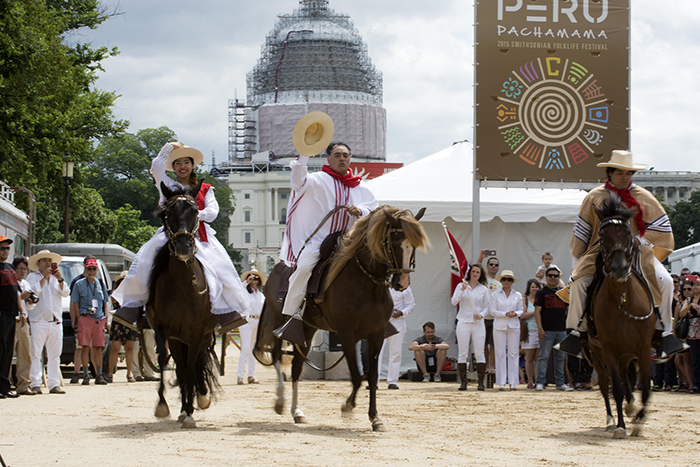While developing the Perú: Pachamama program for the 2015 Smithsonian Folklife Festival, we circled around the question of “Peruvian-ness.” Three major factors both distinguished and unified the diverse traditional cultures that constitute Peru: history, environment, and the knowledge, skills, and the creativity of local communities that use traditional culture both to honor and reinterpret their heritage and to adapt and sustain their ways of life in a changing world.
An antecedent underlying this diversity may be the Inka Empire that was organized into four parts, or suyos. Each suyo was characterized by resources, its deities, and the diverse religious observances, customs, and dress of its peoples. The Inkas built on earlier forms of organization which were not only practical but recognized the value of difference.
During their ten days on the National Mall, the Peruvian Festival participants created their own mini-empire village, reflecting their own differences in environment, history, and traditions while also shaping a sense of Peruvian-ness through their interactions with each other and with the visitors—many of them Peruvian. In addition, the two Festival Community Days, what we initially called a diaspora program, added another dimension of Peruvian-ness, featuring the experiences of Peruvian immigrants in the United States.
To enrich the Community Days, diaspora project coordinator Alexia Fawcett brought together Peruvians living in Washington and New York to form a community advisory committee. During their first meeting, the term “diaspora” was highly contested. The members had many interpretations of the word, and one of the persisting associations is with political and natural catastrophes, oppression, war, and displacement. Many Latin Americans have experienced hunger and violence that have forced them to immigrate; although Peruvians are not exempt, the advisory group preferred to consider their immigration as a choice. They felt “diaspora” misrepresented their experience.

“I’m still struggling with what to call ourselves,” said Fabiana Chiu, a committee member who later presented at the Festival. “Peruchos is not bad. The quinto suyo. But everybody who has spoken about Peruvians here is like, you’re always Peruvian. Some people had to leave under duress and didn’t want to leave it behind. Once you get here things change, but we still feel very strongly Peruvian.”
Fabiana’s pre-Columbian association with the suyos, referencing communities outside the country as the fifth region, expands the country’s territory beyond its borders and contributes to the creation of a cultural imaginary that keeps immigrants connected to Peru as a homeland. “We don’t stop being Peruvians just because we live in another place,” committee member Ana Noriega said. She is clearly not alone: one Festival visitor responded to the survey question about where she is from, “Peru and Virginia.”
Differences within this unifying cultural imaginary are usually expressed through personal stories of immigration. Some, like committee member and musician Billy Castillo, came to the United States as adults; others came as children. Yet others are born here and have a complicated heritage. Elena Tscherny explains to her nine-year-old grandson, “Your father was born in Mexico of a Peruvian mother and a German father, so this is part of your Peruvian heritage.” Cathy Cabel Chicas shares an anecdote prompted by the Festival: “It was so funny. Two days ago my daughter was telling her [Salvadoran] dad, ‘Well, I’m Peruvian,’ and he’s like, ‘You’re not just Peruvian. You’re mixed.’ And she’s like, ‘No, I’m Peruvian.’ She’s six.”
Abroad, a major symbol of Peruvian-ness is the Marinera, a dance with roots in the Spanish fandango, African zamacueca, and Indigenous couple dances. Each region has its own style, punctuated by variations in the tempo, key, clothing, and steps. It is recognized as the “national dance,” though it is not the only dance tradition in Peru. At the Festival, we also featured danza Sarawja from southern Peru, contradanza performed in celebrations of the Virgen del Carmen de Paucartambo, and Afro-Peruvian zapateo from the coastal regions.

Faithful to its diversity, the Marinera crosses regions and boundaries, traveling wherever Peruvians reside. In the United States, it plays a central role in teaching young people about their heritage, stimulating Peruvian-ness in them. From Falls Church, Virginia, to Seattle, Washington, parents send their children to Peruvian dance schools to maintain cultural ties to their homeland. This tradition is at the forefront of social gatherings, celebrations, and, most importantly, contests, forming an important element of Peruvian-ness abroad. The experience of the area dance schools that participated in the Festival not only filled the young dancers with the pride of their Peruvian-ness but reinforced their sense of belonging to a larger homeland.
“I believe that as kids it is hard to understand our parents who are born and raised Peruvians and how much they miss that culture,” said Cathy Cabel Chicas, whose dance students performed at the Festival. “My goal for my students was to represent Peru to the best of their ability. At the same time I want my students to embrace their culture, their country, because they have a piece of Peru with them always.”
Olivia Cadaval has curated numerous Folklife Festival programs, including Las Américas: Un Mundo Musical (2009), México (2010), Colombia: The Nature of Culture(2011), and Perú: Pachamama (2015).
Reference
Cohen, Robin. 1997. Global Diasporas: An Introduction. Seattle: University of Washington Press.


